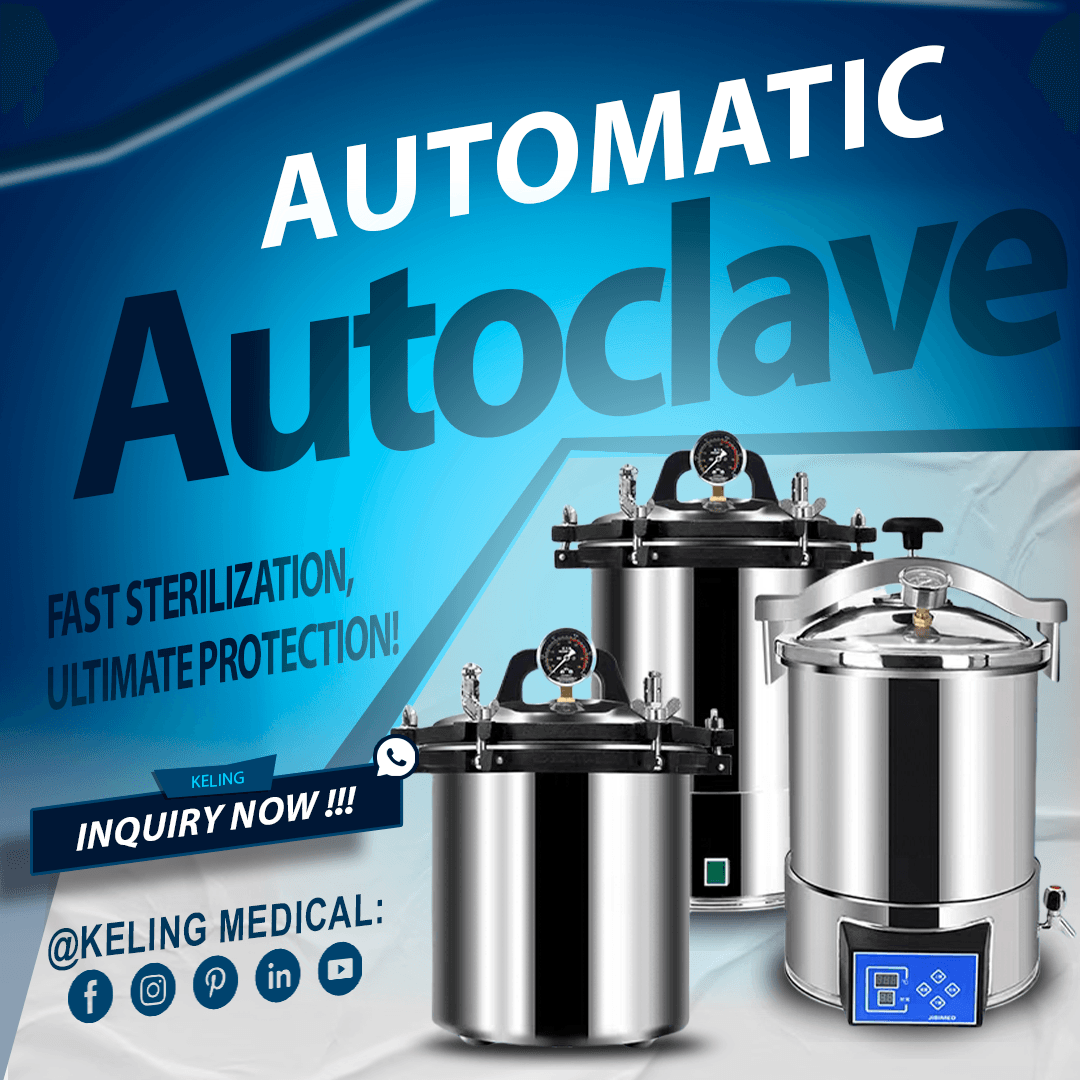
この包括的なガイドでは、オートクレーブの定義と意味を探り、その歴史的ルーツをたどり、核となる構成要素を説明し、医療を中心とした複数の産業における重要な役割を検証します。この記事を読み終える頃には、オートクレーブと、現代の滅菌プロセスにおけるその重要性を完全に理解していることでしょう。
オートクレーブが誕生して滅菌方法が劇的に変わるまで、滅菌は何百年も行われてきた。1879年、フランスの微生物学者シャルル・チェンバーランドは、ルイ・パスツールと共に働きながら、最初のオートクレーブを開発した。この技術革新は、安全性を維持し感染を防ぐために、手術器具や実験器具に存在する危険な微生物を破壊する必要性から生まれた。
初期の滅菌法では熱湯や乾熱を使用していたが、強靭な細菌の芽胞を破壊することはできなかった。加圧蒸気で作動するオートクレーブの開発は、滅菌方法に大きな進歩をもたらした。医療界や科学界はこの技術を急速に基準規格として採用し、現代の滅菌法の基礎を築いた。
オートクレーブは、高圧飽和蒸気を高温で使用し、機器や材料から微生物を除去する特殊な滅菌装置として機能します。オートクレーブは、細菌、ウイルス、真菌、芽胞を含むすべての微生物生命体を除去するプロセスであるため、無菌性を必要とする環境には不可欠です。
滅菌装置は一般に、"オートクレーブ"、"オートクレーブ"、"オートクレーブ "と呼ばれる。この用語のすべてのバージョンは、医療、実験、工業用器具の清浄度と安全性を維持する同一の重要な装置を指す。
オートクレーブ」という用語は、ギリシャ語とラテン語の語源に由来し、「自動ロック」機構を表している。この用語は、完全な滅菌に必要な圧力と熱を保持するために、装置が運転中に気密シールを作成する方法を説明します。
オートクレーブの基本的な部品に習熟することは、医療機器の調達と流通に携わる者にとって不可欠である。オートクレーブの設計は細部で異なるが、標準的な必須部品一式が含まれている。
チャンバーの内部空間は、滅菌が必要な物品を置く場所として機能する。チャンバーは通常ステンレス製で、高い圧力と温度レベルの両方に耐えることができる。
丈夫で安全な密閉ドアや蓋は、運転中も庫内を密閉し、内圧を維持しながら蒸気の漏れを防ぐ。
蒸気発生器は、滅菌プロセスに必要な飽和蒸気を発生させます。オートクレーブによっては、スチームジェネレーターを内蔵しているものもあれば、外部スチーム源に依存しているものもあります。
最新のオートクレーブのデジタル制御パネルでは、温度設定やサイクル時間など、滅菌のためのパラメーターを調整することができる。
このシステムは、効果的な滅菌を保証し、ユーザーを保護する内部条件をモニターし、制御するためにセンサーを使用する。
安全弁はオートクレーブ内の過剰圧力を管理し、安全な運転限界を維持しながら事故を防止する。
排気システムは、滅菌後に蒸気と圧力を放出し、庫内を冷ましてから開けることができる。
オートクレーブは、加圧された蒸気を使用して水の沸点以上の温度を達成することによって機能し、すべての微生物の生命を破壊する。オートクレーブの仕組みについて簡単に説明します。
滅菌器具は道具や材料とともにチャンバー内に入り、蒸気が十分に浸透するように整理される。
扉や蓋をしっかり閉めれば、チャンバーは気密状態になる。
スチーム・ジェネレーターは、チャンバー内に満たされた加熱水からスチームを発生させます。チャンバー内に蒸気が蓄積すると圧力が上昇し、温度が100℃を超え、121℃(250°F)以上に達します。
チャンバーは、負荷の大きさと滅菌の必要性に基づいて15分から30分の範囲で、所定の温度と圧力レベルを保持する。
滅菌サイクルが終了すると、チャンバーの圧力はゆっくりと下がり、冷却が始まります。チャンバーが安全であることを確認した後、医療従事者がドアを開け、滅菌されたものを取り出す。
オートクレーブは、滅菌された内容物から残った水分を除去するための乾燥段階を含むことがある。
オートクレーブは、さまざまな産業で重要な機能を果たすと同時に、それぞれの分野で主要な用途を発揮している。
オートクレーブは、病院、診療所、歯科診療所、手術センターで不可欠な機能を果たしている。オートクレーブの滅菌プロセスは、手術器具や実験用ガラス器具だけでなく、再利用可能な医療機器や一部の医療廃棄物カテゴリーにも及んでいます。
科学実験室では、培地や実験器具を滅菌することで、安全性と実験の完全性を維持するため、オートクレーブに依存しています。
製薬業界では、オートクレーブを使用して、厳しい規制基準に従いながら、製造設備や容器、時には医薬品を滅菌している。
動物病院のオートクレーブは、動物患者を危険から守るため、手術器具や器材を滅菌する。
オートクレーブ滅菌プロセスは、二次汚染や感染を防ぎながら、清潔な針や器具を維持するために極めて重要である。
食品加工用の特殊オートクレーブは、包装を殺菌し、缶詰を通して食品の保存期間を延ばすために存在する。
バイオハザード廃棄物の処理にオートクレーブを使用することで、適切な廃棄のための安全性が確保される。
オートクレーブは、医療研究所や産業施設全体の衛生・安全基準を維持するために不可欠な機械です。流通業者、販売業者、および調達の専門家は、現代の医療と産業の要件を満たすために、オートクレーブの機能とそのアプリケーションを知る必要があります。
オートクレーブの選択には、チャンバーサイズ、サイクルオプション、安全機能、規制基準の遵守を評価する必要があります。高品質のオートクレーブを選択することで、エンドユーザーを保護し、ビジネスの評判を維持することができます。
お客様のニーズを的確に満たす信頼性の高いオートクレーブソリューションのために、専門家によるガイダンスとサポートをご利用ください。
オートクレーブは、高圧飽和蒸気を用いて医療器具、実験器具、医薬品などを滅菌するために使用される。このプロセスにより、芽胞を含むすべての微生物を確実に除去することができます。
すべてのオートクレーブが滅菌器であるが、すべての滅菌器がオートクレーブであるわけではない。オートクレーブは特に滅菌に圧力下の蒸気を使用するが、他の滅菌器は乾熱、化学薬品、放射線を使用する場合がある。
一般的に滅菌される材料には、手術器具、ガラス器具、繊維製品、ゴム製品、特定のプラスチック、培地などがある。適合性を確認するため、常にメーカーのガイドラインを確認してください。
定期的なメンテナンスには、チャンバーの清掃、シールとバルブの点検、センサーの較正、メーカーが推奨するサービススケジュールに従うことなどが含まれる。
オートクレーブには、重力置換、プレバキューム(高真空)、パススルーオートクレーブなどさまざまなタイプがあり、それぞれ用途や負荷の種類に適しています。
加圧スチームは熱湯よりも高温に達するため、最も抵抗力のある微生物や芽胞も確実に破壊し、完全な殺菌を実現します。
続きを読む オートクレーブ滅菌器とは? そして オートクレーブとは? をご覧ください。
高品質のオートクレーブをお探しですか?私たちのチームは、オーダーメイドのソリューションと専門的なアドバイスでお客様をサポートします。
Eメール inquiry@shkeling.com
WhatsApp: +8618221822482
オートクレーブに関するご相談やお見積もりは、お気軽にお問い合わせください!
注: この記事は、オートクレーブに関する詳細情報を求める医療機器販売業者、ディーラー、調達担当者向けに作成されています。オートクレーブ技術とその応用に関するより詳しい洞察については、お気軽に弊社まで直接お問い合わせください。
特定のファイル形式での記事が必要な場合や、さらなるカスタマイズが必要な場合は、お知らせください!

はじめに 病院で使用されるオートクレーブ装置は、医療インフラにおける最も重要な投資のひとつであり、医療関連感染に対する防御の第一線として機能している。洗練された滅菌装置は

オートクレーブプロセスは、効果的な滅菌によってガラス製品や器具を保護するために、医療、研究所、研究施設などで利用されている重要な滅菌方法です。高圧蒸気はこの工程で病原菌を除去します。

オートクレーブプロセスは、効果的な滅菌によってガラス製品や器具を保護するために、医療、研究所、研究施設などで利用されている重要な滅菌方法です。高圧蒸気はこの工程で病原菌を除去します。